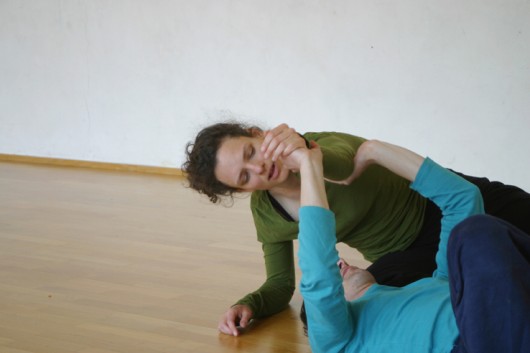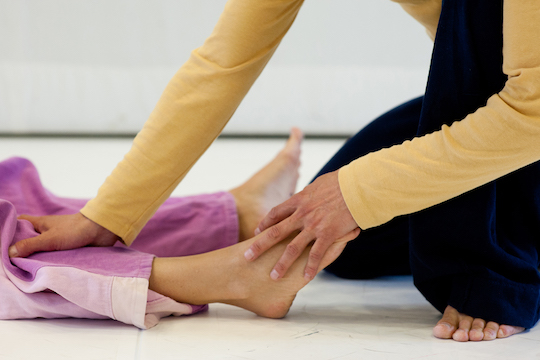Somatic Education

Somatic Education is a holistic way to learn via positive body experiences and to bring your body and mind into harmony. The learning environment of somatic methods in dance strategically directs your attention to specific aspects of movement and posture in order to widen and refine the body awareness and movement repertoire.
rollingpoint conceives of Contact Improvisation and Contemporary Dance as forms of Somatic Education.
Somatic Education is based on the close relationship between learning and body. While cognitive learning primarily happens on the level of thought, somatic learning is immediately bodily experienced.
Movement and touch are the basis of all human developmental processes.
The body memory (Leibgedächtnis) is the key for Somatic Education. Every sensory input leaves an impression in the body memory. Whereas negative experiences like fear mostly manifest subconsciously as blocking tension in the body memory somatic body work strategically and consciously looks for new positive body experiences, freedom of movement and a well-balanced body tonus.
Somatic learning is the most basic form of learning. The history of Somatic Education therefore is as old as the history of humanity itself. Yoga, Tai Chi, Chi Gong, Aikido and other eastern somatic practices have had a profound influence on the development of newer methods in the western hemisphere.
In the German speaking world the pioneering work of Elsa Gindler and Heinrich Jacoby during the development of the reform pedagogics in the 1920ies need mentioning. Elsa Gindler called her work simply “working with the body”.
In the U.S.A. Mabel Todd was the forerunner of research into somatic learning processes. Her book “The Thinking Body”, published in 1937, has become the foundation of the method of improving one’s posture and movement repertoire by becoming aware of anatomical conditions. This method was further developed mainly in the dancing world and later on called “ideokinesis”.
Leading personalities like F.M. Alexander, Moshe Feldenkrais, Gerda Alexander (“Eutonie”), Milton Trager or Bonnie Bainbridge Cohen (“Body Mind Centering”) have developed and propagated various methods of Somatic Education.
Somatic Education methods create a learning environment targeted to direct one’s attention onto certain aspects of movement and posture in order to become aware of them. Verbal instructions, often augmented by anatomical or fanciful imagery, and touch can bring minute changes in muscle tone and other kinaesthetic sensations into the realm of perception.
Contact Improvisation is a special form of somatic learning whereby bodily communication in the here and now continuously discloses new options for action. The dancers learn to move in accordance with their bodies’ anatomy and the principles of physics. The positive outcome of cooperation can be felt in one’s own body and the success of community is fostered in many ways.
In Contemporary Dance we open ourselves to the diversity of movement to awaken and educate our body knowledge. We challenge our habitual mental and physical movement patterns by introducing various requirements, rules, tasks and different forms of attention. In this way movement education becomes Somatic Education.
Scientific results from neurobiology and neurophysiology confirm that a good balance of moving, sensing, feeling, thinking and acting with awareness constitutes a prerequisite for health and healing. Somatic learning enables you to better understand your own body and learn to listen to its signals thereby accepting more responsibility for yourself and your own physical and mental health (see also the notion of “psychosomatic competence [psychosomatische Kompetenz]” by Christian Fazekas, Medical University of Graz).

fotocredit: Laurent Ziegler